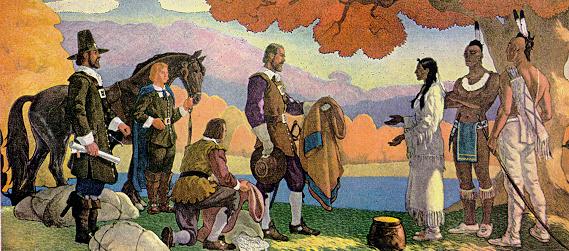The Governor Kieft War

In 1639, the Dutch West India Company resolved to exact tribute from local Indians around New Amsterdam, stating that these Indians were under Dutch protection. Dutch governor Willem Kieft put the taxation proposal this way:
“Whereas the Company is put to great expense both in building fortifications and in supporting soldiers and sailors, we have therefore resolved to demand from the Indians who dwell around here and who heretofore we have protected against their enemies, some contributions in the form of skins, maize and seawan [wampum], and if there be any nation which is not in a friendly way disposed to make such contribution it shall be urged to do so in the most suitable manner.”
Dutch residents who had lived in the area long enough to know the Tappan, Hackinsack, Wickquaesgeck, and Raritan, told the governor that this was the wrong thing to do. The governor, oblivious to the Indian world view, had assumed that the Dutch had purchased the Indians’ land and that the Indians were now under Dutch protection. The Indians, however, did not view the goods they had received as the purchase price of the land, but as a gift which represented the agreement. Both the Indians and the long-time Dutch residents understanding that the agreement involved sharing the land and entering into a defensive alliance.
The following year, Dutch governor Willem Kieft launched an unprovoked attack against the Raritan on Staten Island, New York. This marked the beginning of the Governor Kieft War. The purpose of the war was to reduce the Indians to obedience to the Dutch and to levy tribute. The presumed excuse of the initial punitive expedition was the theft of some hogs on a Dutch farm in Staten Island. In actuality, the thieves were Dutch, not Indian. Governor Kieft, however, sent a posse to a Raritan village and several Indians were killed. The Raritan responded by attacking the farm where the alleged theft had taken place, burning down the house and killing four farm hands.
Governor Kieft, seeing no Dutch culpability in the Raritan response, issued an edict:
“we have therefore considered it most expedient and advisable to induce the Indians, our allies hereabout, to take up arms.”
Ten fathoms of wampum (seawan) were offered to the friendly Indians for each head of a “hostile” Indian which they brought in. Furthermore, if they brought in the head of any Indians who attacked the farm, then this would increase to 20 fathoms. Soon, Pacham, an Indian from a tribal hostile to the Raritan, came to the guardhouse at Fort Amsterdam holding aloft a stick from which dangled a human hand. Pacham then declared to Governor Kieft that the hand belonged to the Raritan chief who had ordered the attack on De Vries’ farm. Kieft felt that his plan to use Indian allies against the Raritan had succeeded.
However, this did not end the war. The following year, the Raritan burned Dutch farmsteads on Staten Island, and captured a number of settlers in retaliation for the Dutch attack against them the previous year. The Dutch asked the Massapequa of Long Island to send war parties against the Raritan. The Dutch once again offered a bounty for the head of any Raritan person.
The war between the Dutch and the Indians soon spread to other tribes. In 1641, a twenty-seven-year-old Wickquasgeck man appeared at the home of Claes Swits. He had a few furs and indicated that he was interested in trading them for some duffel cloth. Since Swits knew the man (whose name is not recorded in the history), he let him in. The Wickquasgeck man then reached for an ax which was near the door and cut off Swits’ head. He then left having revenged the death of his people who had been killed in 1626. In response to this attack, governor Willem Kieft ordered a full-scale retaliation. Kieft felt that once again the Indians had shown that they could never be trusted. Extermination, according to Kieft, was the only solution.
Word of the Dutch war of extermination did not reach all Indians and in 1643, a group of Wecquaesgeek and Tappan sought refuge at Fort Amsterdam as they fled from a war party of Mahican. They did not know that Governor Kieft had argued for the extermination of all Indians who had refused to pay Dutch tribute. In the middle of the night, the Dutch soldiers massacred the sleeping Indians. The soldiers’ cruelty, described by Dutch planter Willem DeVries, included
“infants were torn from their mother’s breasts, and hacked to pieces in the presence of the parents, and the pieces thrown into the fire and in the water, and other sucklings, being bound to small boards, were cut, stuck, and pierced, and miserably massacred in a manner to move a heart of stone.”
About 80 Indians were massacred and the soldiers were rewarded for their services. Willem Kieft thanked them and congratulated them on their victory.
In 1644, the Mahican sachem Aepjen negotiated a peace treaty with the Dutch on behalf of a number of tribes, including the Wappinger and Wiechquaesgeck. Many of the Wiechquaesgeck felt that they could not endure the treaty with the Dutch and subsequently they left their homes and went to live among the Raritan in New Jersey.
In 1645, the Dutch held a council with the Indians in front of their fort at Manhattan. The Dutch wished to negotiate a firm and inviolable peace with the assembled Indian leaders which included Hackinsack leader Oratany, Tappan leader Sesekemu, Rachgawawanck leader Willem, Nyack leader Mayauwetinnemin, and Wickquasgeck leader Aepjen (also known as Eskuyas). At this time, more than 1,000 Indians had been killed in the war against the Dutch.
Both sides agreed to peace and to settle future disputes by discussion rather than violence. Twenty Indian leaders make their marks on the treaty. Aepjen signed the treaty as representing the Wappinger, Wiechquaeskeck, Sinsink, and Kichtawank. The next day, the Dutch ordered a day of general thanksgiving. Thus the Governor Kieft War ended.



